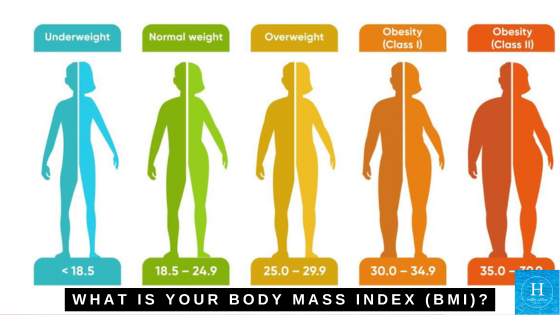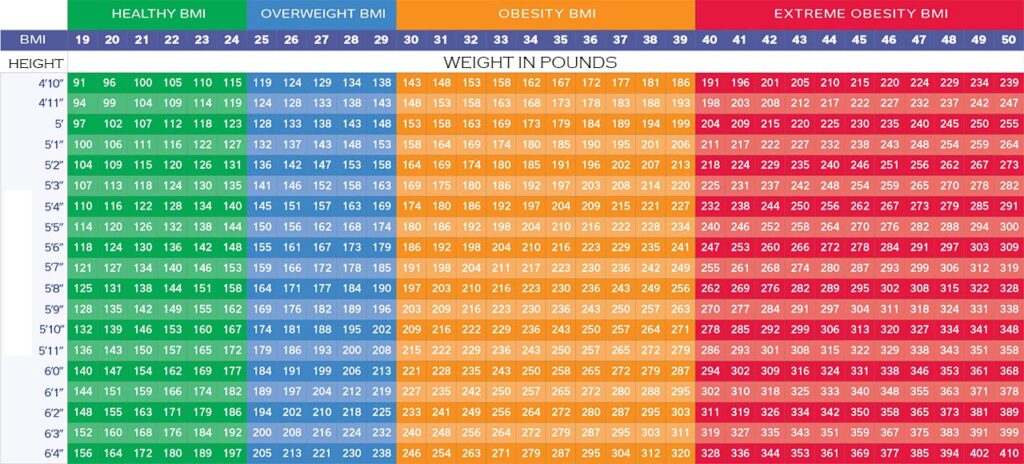What Is Your Body Mass Index (BMI)?

BMI was first introduced in 1830-1850 by a Belgium astronomer.
The modern term “Body Mass Index” (BMI) for the ratio of human body weight to squared height.
It was coined in a paper published in the July 1972 edition of the Journal of Chronic Diseases by Ancel Keys.
BMI is universally expressed in kg/m2, resulting from mass in kilograms and height in meters.
Why Calculate BMI?
A person’s BMI can be used as a screening tool for weight issues.
However, it is not indicative of a person’s overall health.
BMI is used as a general rule to determine if an adult patient is underweight, normal, overweight, obese or morbidly obese.
BMI Ranges:
Underweight: Less than 18.5 BMI
Normal: Between 18.5 and 25 BMI
Overweight: Between 25 and 30 BMI
Obese: Between 30 and 35 BMI
Morbidly Obese: Over 35 BMI
So What Is Your BMI? Calculate your BMI With Our BMI Calculator:
BMI Table For Adults:

For Children ages 2-20, BMI is used differently as a comparison with other children of the same age.
Children below 5 percent BMI are considered underweight and obese if they are above 95 percent BMI compared to other children their age.
BMI roughly correlates to increasing heart disease, diabetes, arthritis, and other chronic diseases.
There is some debate about BMI and it’s use and accuracy.
Can BMI be misleading?
BMI can be misleading in those patients with larger than average muscle mass and higher than average fat mass.
An example where BMI does not correlate with health status would be a body builder with low body fat that may screen with an obese BMI.
Another example would be a middle aged female with normal BMI may actually have very high body fat percentage and low muscle mass (aka- skinny fat).
The important factors that make up weight are muscle and fat.
Definitions of ‘overweight’ based on body fat percentages use a male threshold of 25% body fat and female of 33%.
Studies show that BMI may average a 2-point discrepancy when analyzing bod fat percentage.
BMI for Women vs. Men

Women carry more body fat then men typically.
There is debate whether there would be different overweight cut off values for men and women.
However, men usually carry more muscle which weighs more.
Knowing these variables using body composition will help shed more light on a patient’s true health status and help health care providers better direct patients on their health risks and nutrition and exercise goals.
BMI is a quick screening tool that can help establish some risks but ultimately each individual patient should be assessed based on their actual body fat percentage.

If you are located near Doylestown, Warrington, or Newtown, PA or the surrounding cities and are interested in learning more about your BMI or need help losing weight, schedule a medical weight loss appointment with Dr. Luciano.
There are more accurate tools that Dr. Luciano utilizes in his practice such as our Body Composition Test.
Did you learn something new or liked this article? Why not share it!
You may also enjoy reading “Introducing Bioidentical Hormone Therapy at Healthy Solutions Medspa: A New Era of Wellness“

Three Reasons to Have Laser Hair Removal Done in Winter
There is no denying that laser hair removal treatments will help you get rid of unwanted hair on your legs, arms, bikini area, face, chest

Vitamin C IV: It’s More Than Just A Vitamin
Vitamin C (ascorbic acid) is a vitamin your body needs to form blood vessels, cartilage, muscle and collagen in bones. Vitamin C is also vital

7 Reasons Why You Should Try IV Vitamin Therapy Treatments
IV Vitamin therapy treatments are the latest health trend that’s making headlines across the United States! IV Vitamin therapy has become popular with everyone from

Botox vs. Fillers: Key Differences, Benefits, and Best Uses
Botox vs. Filler What is Botox? Botox is a treatment that temporarily reduces wrinkles and fine lines by relaxing facial muscles. It’s a go-to option

Why the Hydrafacial is Great To Do in the Winter
The Hydrafacial is quickly becoming one of the most sought after skin treatments available. With immediate effects and no downtime, it became obvious that this

Rewind the Clock: How Botox and BBL Photofacials Work Together for a Youthful Glow
When it comes to achieving radiant, youthful skin, a one-size-fits-all approach rarely delivers the best results. That’s why combining treatments such as Botox and BBL

